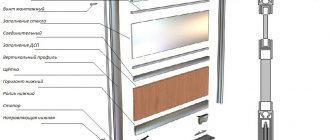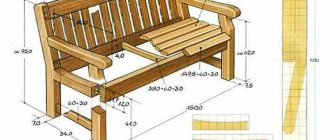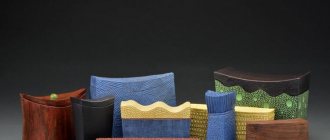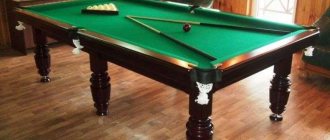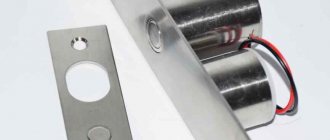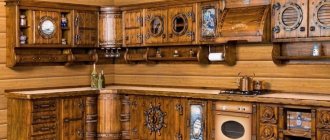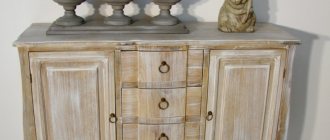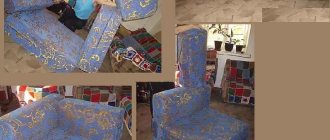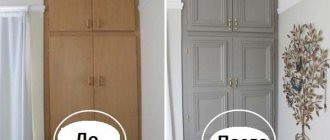0
31124
Thanks to the successful selection of a wardrobe or wardrobe system for the bedroom, living room, children's room and even the corridor, you can significantly save living space. This becomes especially important in a small apartment, the area of which is quite small. High functionality and practicality of such furniture cannot be ensured without thoughtful internal content, and pantographs for sliding wardrobes are one of the important elements.
Concept
The pantograph is most often used for storing things in wardrobes. This device is also called a “furniture elevator.” And yet, what is a pantograph? From the definition it follows that a pantograph is a structure whose purpose is to improve the function of a wardrobe. It is made of steel or aluminum in a U-shape.
Pantographs are available in several sizes. The size of a furniture lift depends on the width of the cabinet or other furniture where the potential buyer wants to install it. Moreover, the size of the pantograph working rod is not the only thing you should pay attention to when purchasing such a useful device. But more on that later.
Self-production of the machine
Homemade milling and copying machine.
If desired, the copy-milling device can be assembled independently, as they say, at home. The main thing is to find the correct drawings of a wood pantograph with your own hands.
What is clear is that such a miniature machine will not be able to work on par with industrial analogues. However, it will create simple copies of wooden products and parts.
A homemade unit can be assembled from a system of rods and an electric drive with an installed chuck clamp, which is necessary for the cutter-mill.
Typical components of a homemade device are few in number:
- work table;
- supporting bed (frame);
- electric motor with milling head;
- pantograph.
Note! A desktop device needs to be optimized for specific tasks. For example, for copying threads. Having determined which wooden workpieces you will have to process, you need to calculate the dimensions, power of the unit, etc.
Purpose of the device
Usually, people who want to purchase or make a furniture elevator themselves are less interested in the exact definition of this concept. And indeed, the answer to the question “pantograph - what is it” does not give an accurate idea of whether it is needed at all?
In fact, this mechanism is practical and interesting. If you list all its useful functions, you will get something like this:
- storing things in empty compartments of the wardrobe;
- systematization of clothing according to the “winter-summer” principle;
- assistance with daily activities for people with disabilities, children or short adults;
- space saving;
- maintaining a neat and tidy appearance of clothing.
As you can see, a pantograph for a closet is quite a useful thing. And it will undoubtedly find its application in every home.
Advantages and disadvantages
In most cases, a pantograph helps improve the quality of life. But it also has disadvantages.
- makes it easier to find, get and hang things in the closet;
- improves ventilation: clothes are fresher;
- makes it easier for older people and people with disabilities to get things;
- frees up the lower part of the cabinet for additional shelves;
- reduces the need for ironing: you can hang more clothes than in a regular closet.
The main disadvantage is wear and tear over time. Gradually, backlashes form between the structural parts, which disables the entire mechanism.
It is almost impossible to repair individual parts of the pantograph; the entire system has to be replaced.
This design is inferior to a conventional horizontal hanger bar, which can last forever
Another drawback is the possible creaking of parts during operation. This becomes a problem if the closet is located in a shared bedroom. Compared to a regular bar, pantographs are significantly more expensive and require more complex installation.
Types of pantograph
Classification of furniture elevators is carried out according to three criteria: size, material and principle of operation. If everything is clear with the size and material, then you should pay closer attention to the principle of operation. So, according to the principle of operation, furniture elevators are:
- electrical;
- mechanical.
If we talk about convenience, then the electric pantograph is simpler and easier to use. But mechanical models are still more popular due to their affordable price. An electric furniture elevator costs several times more and is much more difficult to install than a mechanical one. But people with good incomes are not afraid of such shortcomings of the electric model.
Advantages and disadvantages of the Pantograph sofa
The Pantograph sofa has a number of significant advantages. First of all, it is an affordable price and chic modern design. The qualitative advantages of the model are:
- Simplicity of the mechanism and components of the product;
- Rare breakdowns and operational defects;
- No risk of damage to the floor covering during the transformation process;
- Availability of additional storage space;
- Possibility of placing the product close to the wall;
- Ideally flat sleeping area.
Particular attention should be paid to the luxurious mattress of the “Pantograph” sofa. Sleeping on it every day is not only convenient, but also useful. Most often, the base contains an orthopedic frame or an independent spring block. Good support for the spine and proper distribution of the load during sleep contribute to better sleep and a person’s emotional state.
The Pantograph sofa has no disadvantages. Some people cite the relatively high cost as a disadvantage. However, the list of benefits compensates for the costs and as a result, you still have a comfortable modern sofa in use that really makes life easier.
Operating principle
Pantograph - what is it from a technical point of view? Most of the pantograph's structure is made of metal. Some of its individual elements may be made of plastic. Aluminum or steel of a furniture elevator has a galvanic coating or other silver or black coating.
The design of the furniture pantograph consists of:
- two side levers;
- working sliding rod;
- fixing elements;
- lifting mechanism;
- handles for controlling the elevator (in mechanical models).
The transformation mechanism (lifting mechanism) is represented by a system of springs that ensure the return of two side arms to their original position. This means that when a person lowers the barbell down using the handle, the levers bend the metal plates in the lifting mechanism, thereby causing stress on them.
This mechanism is used not only for mechanical elevators; for example, on sale you can find a sofa with a pantograph mechanism. According to the principle of operation, such a sofa resembles a Eurobook. But nevertheless, it has its own peculiarity - the absence of rollers. Sofas with this design are reliable and resistant to wear. The transformation mechanism, for all its versatility and practicality, is quite simple, so some craftsmen manage to independently build such a structure at home.
Pantograph for a cabinet - everything you need to know about this type of structure
Today we will figure out how to make your closet more convenient to use using a device such as a pantograph. This is a special system that allows you to raise and lower the bar under the hangers at the moment you need. Thanks to this design, compartments with clothes can be located in the upper part of the closet, freeing up space below for shelves.
Pantograph is a very convenient element in modern clothing storage systems
Characteristics
Its capabilities depend on the main characteristics of the pantograph. Therefore, when purchasing this device, you need to pay attention not to its aesthetics, but to two basic parameters: load capacity and size.
The weight that a furniture pantograph can hold ranges from 8 to 20 kg. The greater the load capacity of a furniture elevator, the more expensive it will cost its customers. The cheapest models can easily hold 10 kg of clothing. Therefore, if you plan to hang children's clothes or light clothes (T-shirts, shirts, etc.), then there is no point in overpaying for the excessive carrying capacity of the device.
The size of the pantograph structure is characterized by the height of the arms and the width of the working rod. On sale you can easily find a furniture lift for connectors 450x600 mm and 600x830 mm. There are models that can be installed in wider niches of the wardrobe, but, as a rule, they are subject to more stringent requirements.
Differences between the Pantograph mechanism
Each new transformation mechanism is based on an already known variant. It is being improved and becomes simpler, more convenient and durable. The prototype of the pantograph is the well-known Eurobook. They are similar in the method of transformation, but have some significant differences.
When transforming the Eurobook, the retractable part is in direct contact with the floor and the speed of unfolding the product depends on the quality of the floor covering. A common problem noted by customers is carpets that are constantly collected under the sofa. There are no dependencies when unfolding the pantograph. The sofa independently lifts into the air and lowers the seat. The only part that will touch the floor are the legs.
The automatic pantograph is an even more convenient model compared to the Eurobook. After parallel installation of the seat, the backrest lowers independently. This means reaching for her through everything. The width of the unfolded sofa is no longer needed.
The comparative disadvantage of the pantograph in relation to the Eurobook is the high cost of the mechanism itself. Therefore, repairing and replacing a Eurobook will be much cheaper. But even a pantograph may never break down in its entire life!
Device durability
First of all, the durability of the pantograph depends on the quality of the mechanism. If the springs, with the help of which the levers are returned to their original position, were not made in compliance with the standards, then the pantograph itself may very soon become unusable.
The quality of the coating of the metal parts of a furniture elevator determines its appearance. Over time, the coating may crack and peel, which, of course, will not interfere with the operation of the pantograph, but will significantly spoil the purchasing experience.
To make sure how long the device can last, check with the seller for the guaranteed number of operating cycles. That is, how many ups and downs the transformation mechanism is designed for. The more lifting cycles the manufacturer guarantees, the longer the device itself will last.
Prices for furniture pantographs are in a wide range: from 800 to 5000 rubles. Foreign-made furniture elevators will cost buyers more than domestic ones. But contrary to popular opinion, domestically produced pantographs are in no way inferior in quality and technical characteristics to devices of foreign brands.
Characteristics and distinctive features
The “pantograph” design is easy to operate, having a pendulum mechanism based on the principle of transformation, which occurs in two stages. The use of spring blocks and rods ensures synchronization of movement, and the absence of auxiliary parts significantly increases the strength and reliability of the piece of furniture, while reducing its cost.
In order to unfold a sofa with a pantograph mechanism, you only need to pull the loop securely sewn to the seat, causing it to rise upward. After this, the seat easily moves forward, holding on to the lower part, and then the backrest lowers.
Important! The difference from other similar devices is the absence of roll-out rollers when unfolding, which, with frequent use, can damage the floor covering.
The cost of sofas with this mechanism directly depends on the country of origin of the components and transformation options, which are:
- Manual. The most affordable option, due to the fact that there is a need to manually remove the pillows from the back and then transfer them to the empty part of the sofa.
- Automatic. A rather expensive solution, but it does not require any effort due to the fact that after the seat is pulled out, the cushions automatically fall into the free space.
Advantages and disadvantages of such a scheme
Transforming sofas with a pantograph mechanism have an attractive price, beautiful modern design and a large number of technical advantages. Their most significant advantages include:
- Simplicity of design ensuring reliability in use.
- No damage to the flooring or wrinkled carpets.
- Easy transformation, rare breakdowns, no squeaks.
- A spacious drawer for storing bed linen and other attributes.
- Attractive appearance, compact dimensions when folded.
- The ability to install the sofa close to the wall, while saving space in the room.
- An absolutely flat surface that guarantees comfort while sleeping.
An additional advantage of the pantograph mechanism is that it does not have any disadvantages. There is only one point that is often paid attention to - the higher cost compared to sofas equipped with roll-out casters. This is a rather ambiguous opinion, because the huge list of positive qualities of furniture that has this mechanism allows you to not pay absolutely no attention to price comparisons, especially considering that the difference in cost is not so great.
Pantographs are a worthy player in the wardrobe team
The system of pantographs (lifts for storing clothes), invented several decades ago, is incredibly simple and at the same time ingenious. The functional element allows you to optimally organize the storage of things on the upper levels of the closet.
Reference
A pantograph is a metal rod with a lifting mechanism designed for quick access to the upper tier of a wardrobe. A clothes lift can organize a storage area in the ceiling space, expanding the ergonomic capabilities of the closet.
Brilliant simplicity
The function of pantographs for everyday life is simple to explain. Let's imagine a normal working morning. When getting ready for work in a hurry and opening a closet, it is often difficult to find the right thing. It is, of course, neatly folded, but it lies on the very top shelf, which is impossible to reach without improvised means. The pantograph is designed to solve this problem.
Pantograph (furniture lift) is a metal and plastic structure in the form of a U-shaped connection, intended for installation in dressing rooms and wardrobes. With its help, it is easy to remove clothes from the upper sections of the furniture, and they will never get wrinkled. Simply pull the special handle and the entire bar with hangers will fall down. With a slight movement, the clothes on the hangers smoothly rise up again.
Anastasia Shenkaryuk, head of the purchasing department of the Furniture Accessories Center:
“With the help of a pantograph for sliding wardrobes, even a child can get clothes from the top shelves. In addition, thanks to pantographs, things on hangers can be placed in two tiers: the first - on a pantograph, the second - on a regular bar. There are four obvious advantages to using pantographs. First, it’s convenient to get things from the top shelf of the closet. Secondly, things are always ventilated. Third, clothes don’t wrinkle. And fourth, there is additional storage space.”
Pantograph type
The designs of pantographs, as we have already noticed, are simple. But there are also fundamental differences - pantographs are mechanical and electrical. For now, the advantage lies with the mechanical type. The second one is too expensive and only a few can afford it.
Anastasia Shenkaryuk:
“The electric pantograph is expensive and difficult to install. The mechanical pantograph is in greatest demand among our clients. It is easy to use and install and is inexpensive.”
Pavel Matiychuk, head of sales department of GTV RUS LLC:
“There are two main types of pantographs on the furniture components market: electrical and mechanical. If the first type of roads requires special skills when installing into furniture, then the mechanical pantograph has gained well-deserved popularity among consumers of high-quality furniture.”
Yulia Maksimenko, head of the Duslar representative office in Novosibirsk:
“There are even electric pantographs with remote control on the market, they are in the premium segment, and the cost of one such set can be equal to the cost of a used car.”
Gas or oil
Choosing a high-quality pantograph based on certain obvious features is not easy; the difference is always in the details. If we talk about the peculiarities of the operation of mechanical pantographs, then there are two methods - gas and oil.
Vyacheslav Balabolin, senior product manager MDM-Komplekt:
“The quality of the gas or oil cartridge is of great importance, but it is most likely impossible to distinguish good from bad within the entire structure. At MDM-Komplekt we carry out multi-level testing, including time testing, before bringing in a new model. For example, a new promising model from China has been undergoing testing for more than 6 months, and this is not the limit. We recommend focusing on a hardware supplier and buying from trusted companies that provide a guarantee for their product.”
Pavel Matiychuk:
“When choosing a quality pantograph, you should pay special attention to the pantograph mechanism used (gas or oil). The specifics of its operation will depend on this. In our experience, furniture manufacturers choose high-quality pantographs that serve the client for a long time. These are basically mechanical oil pantographs that are reliable and have a low noise level, which is especially important when used in wardrobes installed in bedrooms. And, of course, the reputation of the manufacturer or supplier plays a huge role.”
Mounting method
Furniture pantographs also differ in the method of fastening. Classic ones are attached to two sidewalls, asymmetrical - to one. This, according to Vyacheslav Balabolin, is convenient for narrow sections of the cabinet. There are pantographs that attach to the back of a cabinet or wall. Such options are optimal for dressing rooms, where all elements are attached to the wall and the design does not involve the installation of vertical racks (sidewalls).
Yulia Maksimenko:
“The classic option - fastening to the sidewalls - is installed in 90% of cases. Pantographs mounted to a wall or to one side panel are installed mainly in dressing rooms.”
Load capacity
The most important characteristic when choosing a pantograph is its load capacity. It directly affects the features of use in furniture. There are relatively low-power pantographs with a force of up to 10 kg; these are perfect for storing blouses, shirts and other light clothing. The golden mean for a pantograph in terms of load is considered to be 12-15 kg. In most cases, according to Vyacheslav Balabolin, this is enough for comfortable use in any openings and with any clothing.
Anastasia Shenkaryuk:
“When choosing a pantograph, it is important to take into account such a criterion as the load on the mechanism. If the pantograph is intended for light clothing, its load capacity can be about 10 kg. If it is important to store outerwear, then a lift with a load capacity of 10 kg can quickly become unusable. A pantograph that can withstand a load of 15-20 kg is suitable for such tasks.”
Who to install
Pantographs are installed mainly in furniture of the middle and premium segments. According to Pavel Matiychuk, such a mechanism will successfully complement premium furniture, make it more functional and, as a result, more attractive to the buyer. Inexpensive models, as a rule, do not have pantographs.
Yulia Maksimenko:
“The choice of one or another filling, of course, depends on the class of furniture purchased. At the same time, today more and more people are aware of the importance of functionality and are willing to pay for it. And any functional parts are what are primarily subject to active daily load, so high quality is especially important here. But in any case, the client always chooses the filling according to his wallet.”
Vyacheslav Balabolin:
“Price segmentation is an integral classifier of any modern market. But the pantograph itself is not a sign of expensive furniture. It is important that this is a functional element that optimizes the storage of things on the upper levels of the closet. The consumer must clearly understand what it is and why he is ordering it, and only then understand the prices.”
Variety of solutions
There are models from different manufacturers, Asian and European, on the furniture market. Since pantographs are installed in furniture of a more expensive segment, they must be made at a high level. And price is not the first selection criterion here. Therefore, preference is given to manufacturers who have proven themselves in the market.
AMBOS (Italy)
A confident leader in the mid-price segment in terms of quality and range. The Italian manufacturer relies on affordable prices, a wide functional range and European quality. Ambos pantographs look great, which allows you to install them without being tied to the price segment of the furniture.
Anastasia Shenkaryuk:
“Ambos has been designing cabinetry since 1977. All Ambos products are manufactured to quality standards; they are reliable, durable and absolutely safe for both humans and the environment. From a design point of view, Ambos pantographs look stylish and ergonomic: they are made in chrome with gray plastic and will fit perfectly into any interior.”
Vyacheslav Balabolin:
“The SuperLift pantograph from the Italian company AMBOS is the only pantograph on the furniture market that can adjust the load from 14 kg to 20 kg. This allows the pantograph to be adapted to the current load.”
Vibo (Italy)
Ambrogio pantographs from Vibo (Italy) are a product for cabinets with a claim to perfection. According to Vyacheslav Balabolin, in a cabinet where not only the facade, but also the body is painted, it is worth installing this particular model:
"Ambrogio is premium from every point of view."
Servetto (Italy)
The Italian company Servetto was founded in 1972 specifically for the purpose of producing pantographs (clothing lifts), the first prototype of which was invented and patented back in 1968 by one of the company’s co-owners. Servetto pantographs are highly reliable, they serve like a Swiss watch for many years, operate silently, withstand high loads and are fixed when lowering/raising.
Yulia Maksimenko:
“We offer products in different segments. In the premium category, in my opinion, Servetto has the most interesting options. Their pantographs, in addition to high quality and reliability, are also interesting from the point of view of design and variability of choice. They come in a wide range of colors – grey, white, brown, gold, platinum and copper.”
GTV (Poland)
Decent quality and affordable price are the criteria for pantographs from the famous Polish brand. Pantographs from this manufacturer are available in six sizes and load capacity options. Spectacular appearance - a combination of steel or aluminum with black or white plastic guarantees consumer attention.
TM Lemax (China)
Products from Chinese manufacturers are also represented in this segment. An important point that Russian suppliers pay attention to is to be sure that these pantographs are manufactured by a reliable company. One of these is the brand TM Lemax, well-known not only in China. It is represented in Novosibirsk by the Furniture Accessories Center.
Trends
The pantograph system is quite simple and there is no need to talk about know-how. In terms of design, the pantograph is valued for its functionality, so it is rare that a serial manufacturer takes on the task of developing an unusual design for this product. Here, according to Pavel Matiychuk, only playing with colors and materials is possible.
The Italians managed to implement interesting design ideas here too. Yulia Maksimenko says that in 2015, the Italian manufacturer Servetto released a completely new original Only pantograph with non-standard stands - the vertical stand is made in the form of a drop. In 2021, at the Interzum exhibition, Servetto showed new color solutions for its products, including pantographs. Now they are also available in platinum, gold and copper colors.
Vyacheslav Balabolin also emphasizes that despite the stinginess of the pantograph world for new developments, changes have nevertheless occurred over the past few years. Traditionally, all innovations are in the upper price segment. Thus, smooth stopping systems began to be integrated into pantograph mechanisms.
For example, Ambrogio from Vibo (Italy) maintains uniform forward motion in any direction and regardless of the load. Vibo engineers were able to get rid of the sudden start and stop of the mechanism during the lifting phase. The pantograph moves so smoothly that the hangers on it hardly sway. Another breakthrough of the Ambrogio model was its appearance. The combination of matte and glossy texture, drop-shaped base and stylish ergonomic handle meet all the requirements of modern design. More recently, the pantograph has become available in two colors: gray and white.
Vyacheslav Balabolin:
“We should also mention the related products for the pantograph: this is a retractable MiniTube rod. This little accessory is a temporary home for hangers. Most consumers prefer not to keep pantographs in the down position and, having removed the necessary hangers, rush to lift the pantograph into place. To avoid throwing things around, you can hang them on this small retractable rod.”
So, pantographs are convenient, functional, and, as it turns out, can be effective from a design point of view. In the middle and premium segments, this is already a standard element of the interior filling of the dressing room. But it is likely that manufacturers of inexpensive sliding wardrobes will soon pay attention to pantographs. After all, the consumer is changing, and, as one of the experts noted, he already understands that price is not the only determining indicator. It is important how useful and convenient the product turns out to be.
Irina Kashina
